Comprehensive Treasury Risk Analysis Assignment - Finance
VerifiedAdded on 2022/08/21
|10
|2003
|12
Homework Assignment
AI Summary
This finance assignment delves into treasury risk management, focusing on interest rate parity, arbitrage opportunities, and currency swaps. Question 1 examines interest rate parity between the US and Britain, calculating forward rates and exploring covered interest arbitrage. It investigates the presence of arbitrage profits and explains the differences in parity forward rates derived through different methods. Question 2 analyzes a currency swap scenario, outlining cost savings for companies, constructing a swap diagram, calculating effective fixed rates, and assessing the impact of interest rate fluctuations. It also discusses the risks associated with swap agreements, including swap price risk and credit default risk, particularly in the context of the 2008 financial crisis. The assignment provides a comprehensive overview of treasury risk concepts and their practical implications in financial decision-making.
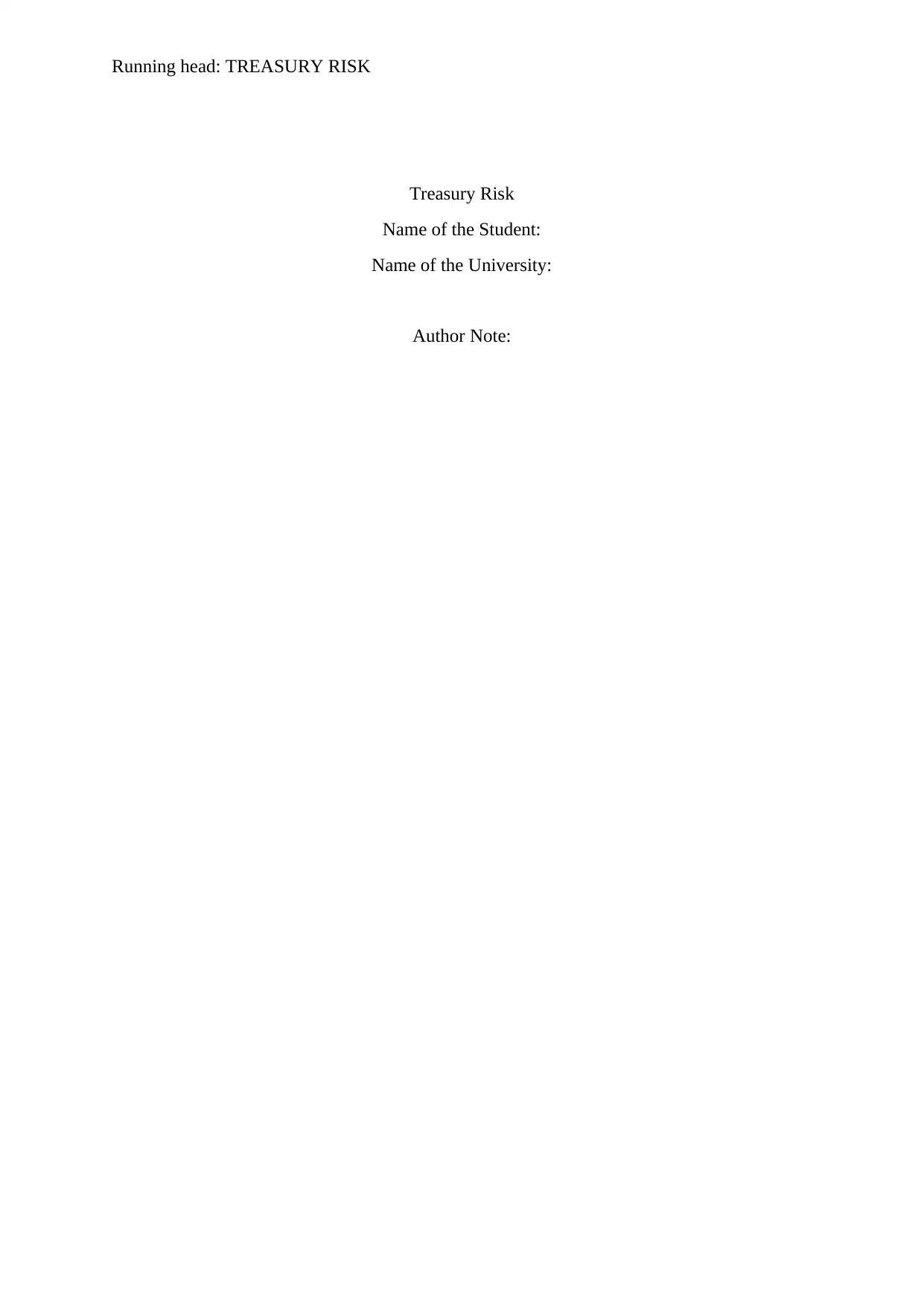
Running head: TREASURY RISK
Treasury Risk
Name of the Student:
Name of the University:
Author Note:
Treasury Risk
Name of the Student:
Name of the University:
Author Note:
Paraphrase This Document
Need a fresh take? Get an instant paraphrase of this document with our AI Paraphraser
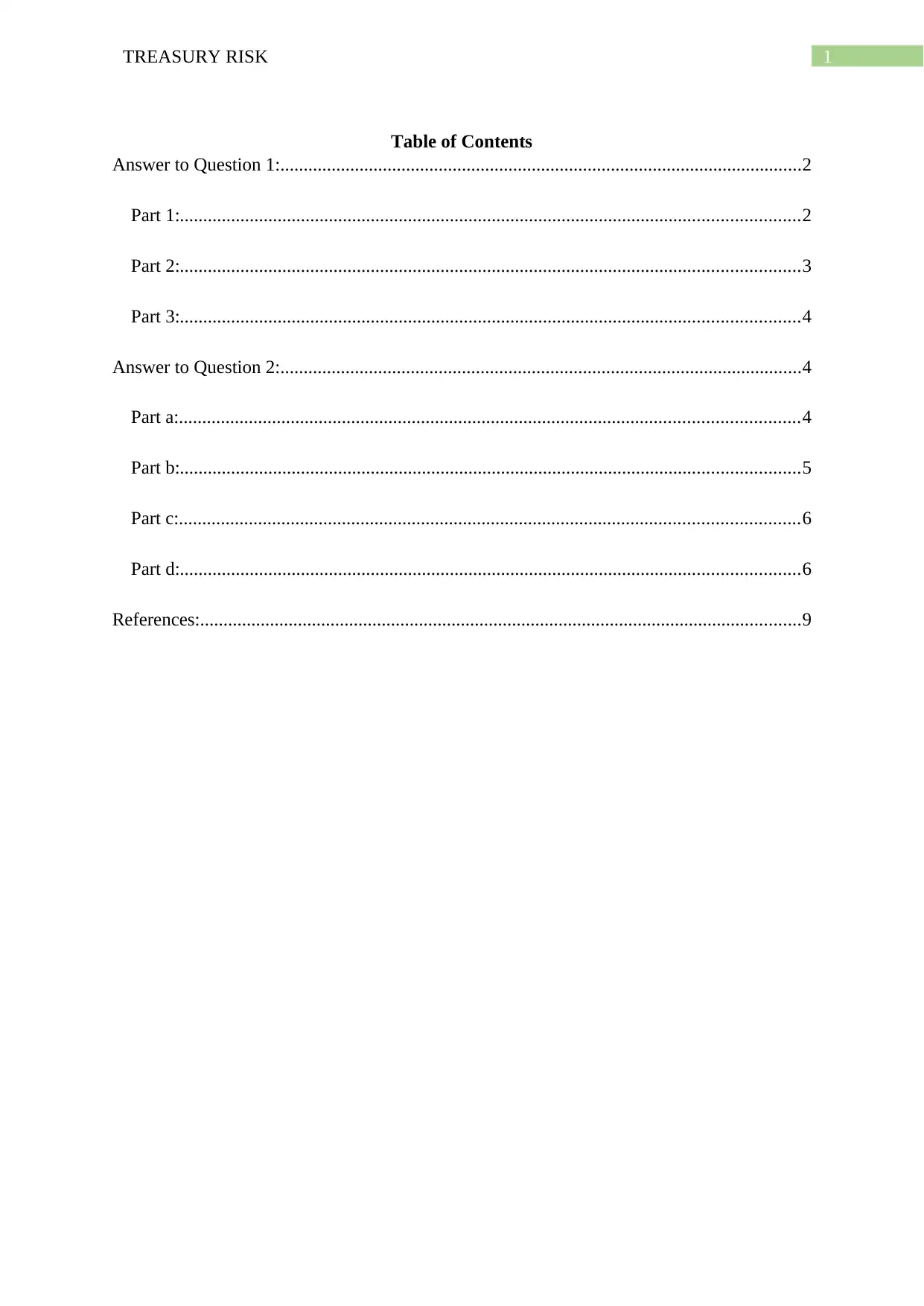
1TREASURY RISK
Table of Contents
Answer to Question 1:................................................................................................................2
Part 1:.....................................................................................................................................2
Part 2:.....................................................................................................................................3
Part 3:.....................................................................................................................................4
Answer to Question 2:................................................................................................................4
Part a:.....................................................................................................................................4
Part b:.....................................................................................................................................5
Part c:.....................................................................................................................................6
Part d:.....................................................................................................................................6
References:.................................................................................................................................9
Table of Contents
Answer to Question 1:................................................................................................................2
Part 1:.....................................................................................................................................2
Part 2:.....................................................................................................................................3
Part 3:.....................................................................................................................................4
Answer to Question 2:................................................................................................................4
Part a:.....................................................................................................................................4
Part b:.....................................................................................................................................5
Part c:.....................................................................................................................................6
Part d:.....................................................................................................................................6
References:.................................................................................................................................9
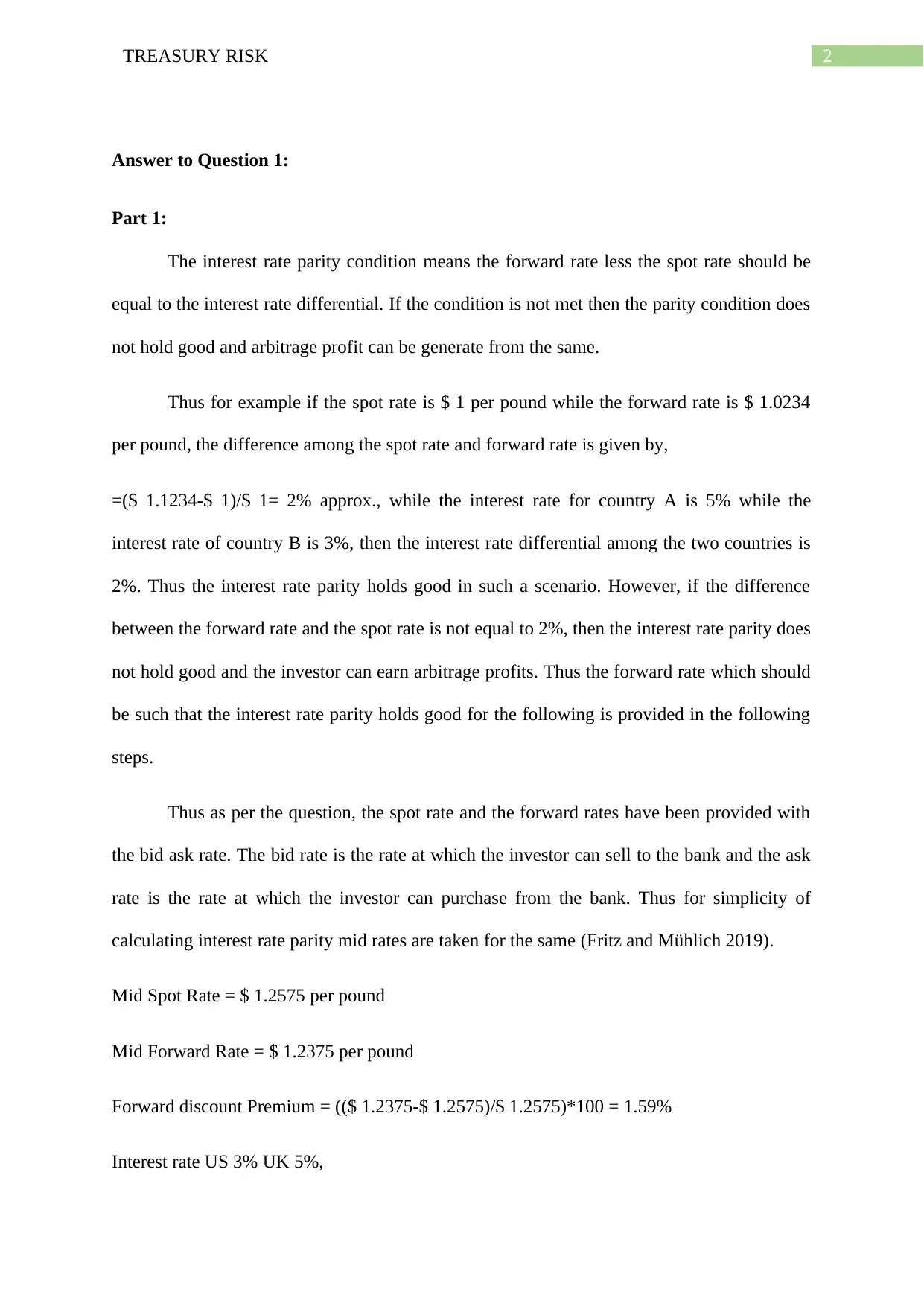
2TREASURY RISK
Answer to Question 1:
Part 1:
The interest rate parity condition means the forward rate less the spot rate should be
equal to the interest rate differential. If the condition is not met then the parity condition does
not hold good and arbitrage profit can be generate from the same.
Thus for example if the spot rate is $ 1 per pound while the forward rate is $ 1.0234
per pound, the difference among the spot rate and forward rate is given by,
=($ 1.1234-$ 1)/$ 1= 2% approx., while the interest rate for country A is 5% while the
interest rate of country B is 3%, then the interest rate differential among the two countries is
2%. Thus the interest rate parity holds good in such a scenario. However, if the difference
between the forward rate and the spot rate is not equal to 2%, then the interest rate parity does
not hold good and the investor can earn arbitrage profits. Thus the forward rate which should
be such that the interest rate parity holds good for the following is provided in the following
steps.
Thus as per the question, the spot rate and the forward rates have been provided with
the bid ask rate. The bid rate is the rate at which the investor can sell to the bank and the ask
rate is the rate at which the investor can purchase from the bank. Thus for simplicity of
calculating interest rate parity mid rates are taken for the same (Fritz and Mühlich 2019).
Mid Spot Rate = $ 1.2575 per pound
Mid Forward Rate = $ 1.2375 per pound
Forward discount Premium = (($ 1.2375-$ 1.2575)/$ 1.2575)*100 = 1.59%
Interest rate US 3% UK 5%,
Answer to Question 1:
Part 1:
The interest rate parity condition means the forward rate less the spot rate should be
equal to the interest rate differential. If the condition is not met then the parity condition does
not hold good and arbitrage profit can be generate from the same.
Thus for example if the spot rate is $ 1 per pound while the forward rate is $ 1.0234
per pound, the difference among the spot rate and forward rate is given by,
=($ 1.1234-$ 1)/$ 1= 2% approx., while the interest rate for country A is 5% while the
interest rate of country B is 3%, then the interest rate differential among the two countries is
2%. Thus the interest rate parity holds good in such a scenario. However, if the difference
between the forward rate and the spot rate is not equal to 2%, then the interest rate parity does
not hold good and the investor can earn arbitrage profits. Thus the forward rate which should
be such that the interest rate parity holds good for the following is provided in the following
steps.
Thus as per the question, the spot rate and the forward rates have been provided with
the bid ask rate. The bid rate is the rate at which the investor can sell to the bank and the ask
rate is the rate at which the investor can purchase from the bank. Thus for simplicity of
calculating interest rate parity mid rates are taken for the same (Fritz and Mühlich 2019).
Mid Spot Rate = $ 1.2575 per pound
Mid Forward Rate = $ 1.2375 per pound
Forward discount Premium = (($ 1.2375-$ 1.2575)/$ 1.2575)*100 = 1.59%
Interest rate US 3% UK 5%,
⊘ This is a preview!⊘
Do you want full access?
Subscribe today to unlock all pages.

Trusted by 1+ million students worldwide
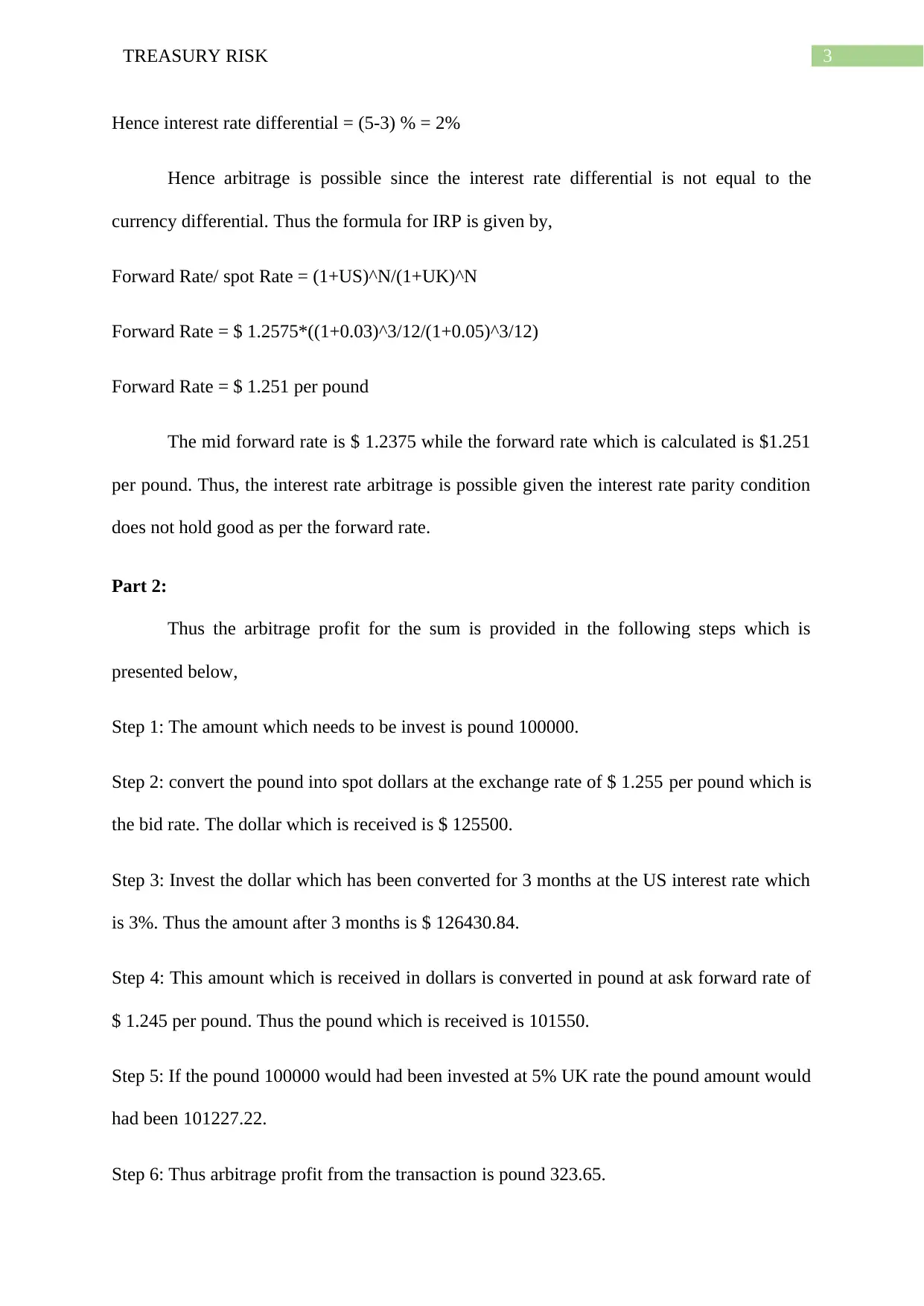
3TREASURY RISK
Hence interest rate differential = (5-3) % = 2%
Hence arbitrage is possible since the interest rate differential is not equal to the
currency differential. Thus the formula for IRP is given by,
Forward Rate/ spot Rate = (1+US)^N/(1+UK)^N
Forward Rate = $ 1.2575*((1+0.03)^3/12/(1+0.05)^3/12)
Forward Rate = $ 1.251 per pound
The mid forward rate is $ 1.2375 while the forward rate which is calculated is $1.251
per pound. Thus, the interest rate arbitrage is possible given the interest rate parity condition
does not hold good as per the forward rate.
Part 2:
Thus the arbitrage profit for the sum is provided in the following steps which is
presented below,
Step 1: The amount which needs to be invest is pound 100000.
Step 2: convert the pound into spot dollars at the exchange rate of $ 1.255 per pound which is
the bid rate. The dollar which is received is $ 125500.
Step 3: Invest the dollar which has been converted for 3 months at the US interest rate which
is 3%. Thus the amount after 3 months is $ 126430.84.
Step 4: This amount which is received in dollars is converted in pound at ask forward rate of
$ 1.245 per pound. Thus the pound which is received is 101550.
Step 5: If the pound 100000 would had been invested at 5% UK rate the pound amount would
had been 101227.22.
Step 6: Thus arbitrage profit from the transaction is pound 323.65.
Hence interest rate differential = (5-3) % = 2%
Hence arbitrage is possible since the interest rate differential is not equal to the
currency differential. Thus the formula for IRP is given by,
Forward Rate/ spot Rate = (1+US)^N/(1+UK)^N
Forward Rate = $ 1.2575*((1+0.03)^3/12/(1+0.05)^3/12)
Forward Rate = $ 1.251 per pound
The mid forward rate is $ 1.2375 while the forward rate which is calculated is $1.251
per pound. Thus, the interest rate arbitrage is possible given the interest rate parity condition
does not hold good as per the forward rate.
Part 2:
Thus the arbitrage profit for the sum is provided in the following steps which is
presented below,
Step 1: The amount which needs to be invest is pound 100000.
Step 2: convert the pound into spot dollars at the exchange rate of $ 1.255 per pound which is
the bid rate. The dollar which is received is $ 125500.
Step 3: Invest the dollar which has been converted for 3 months at the US interest rate which
is 3%. Thus the amount after 3 months is $ 126430.84.
Step 4: This amount which is received in dollars is converted in pound at ask forward rate of
$ 1.245 per pound. Thus the pound which is received is 101550.
Step 5: If the pound 100000 would had been invested at 5% UK rate the pound amount would
had been 101227.22.
Step 6: Thus arbitrage profit from the transaction is pound 323.65.
Paraphrase This Document
Need a fresh take? Get an instant paraphrase of this document with our AI Paraphraser

4TREASURY RISK
Step 7: Thus the parity forward rate using the money market mechanism is
$126430.84/101550 is $1.245.
The parity forward rate is also not equal to the mid forward rate which is being quoted
in the market.
Part 3:
The difference among the parity forward rates in part 1 and part 2 is due to the
assumptions which has been taken for the calculation. In part 1, the mid rates have been taken
to calculate the forward rate using the interest rate parity condition. However, in part 2 the
bid and ask rates have been utilized for the calculation of the amount which can be generated
using the spot and forward rates.
Hence, this is the reason for the difference between the forward rates calculated in
part 1 and part 2.
Answer to Question 2:
Part a:
The cost savings in the swap occurs when the swap parties take loan at different rates
from respective borrowers which leads to the creation of cost savings. Thus, cost savings is
one of the incentive for the parties to enter into a swap. The cost saving from the swap is
highlighted in the points below,
The Fixed rate for the company XX is 8% while the Floating rate for the loan is
Libor+0.24% and the bid ask spread is 0.4%. Thus floating rate for company is
Libor+0.24%+0.4%.= Libor+0.64%
Step 7: Thus the parity forward rate using the money market mechanism is
$126430.84/101550 is $1.245.
The parity forward rate is also not equal to the mid forward rate which is being quoted
in the market.
Part 3:
The difference among the parity forward rates in part 1 and part 2 is due to the
assumptions which has been taken for the calculation. In part 1, the mid rates have been taken
to calculate the forward rate using the interest rate parity condition. However, in part 2 the
bid and ask rates have been utilized for the calculation of the amount which can be generated
using the spot and forward rates.
Hence, this is the reason for the difference between the forward rates calculated in
part 1 and part 2.
Answer to Question 2:
Part a:
The cost savings in the swap occurs when the swap parties take loan at different rates
from respective borrowers which leads to the creation of cost savings. Thus, cost savings is
one of the incentive for the parties to enter into a swap. The cost saving from the swap is
highlighted in the points below,
The Fixed rate for the company XX is 8% while the Floating rate for the loan is
Libor+0.24% and the bid ask spread is 0.4%. Thus floating rate for company is
Libor+0.24%+0.4%.= Libor+0.64%
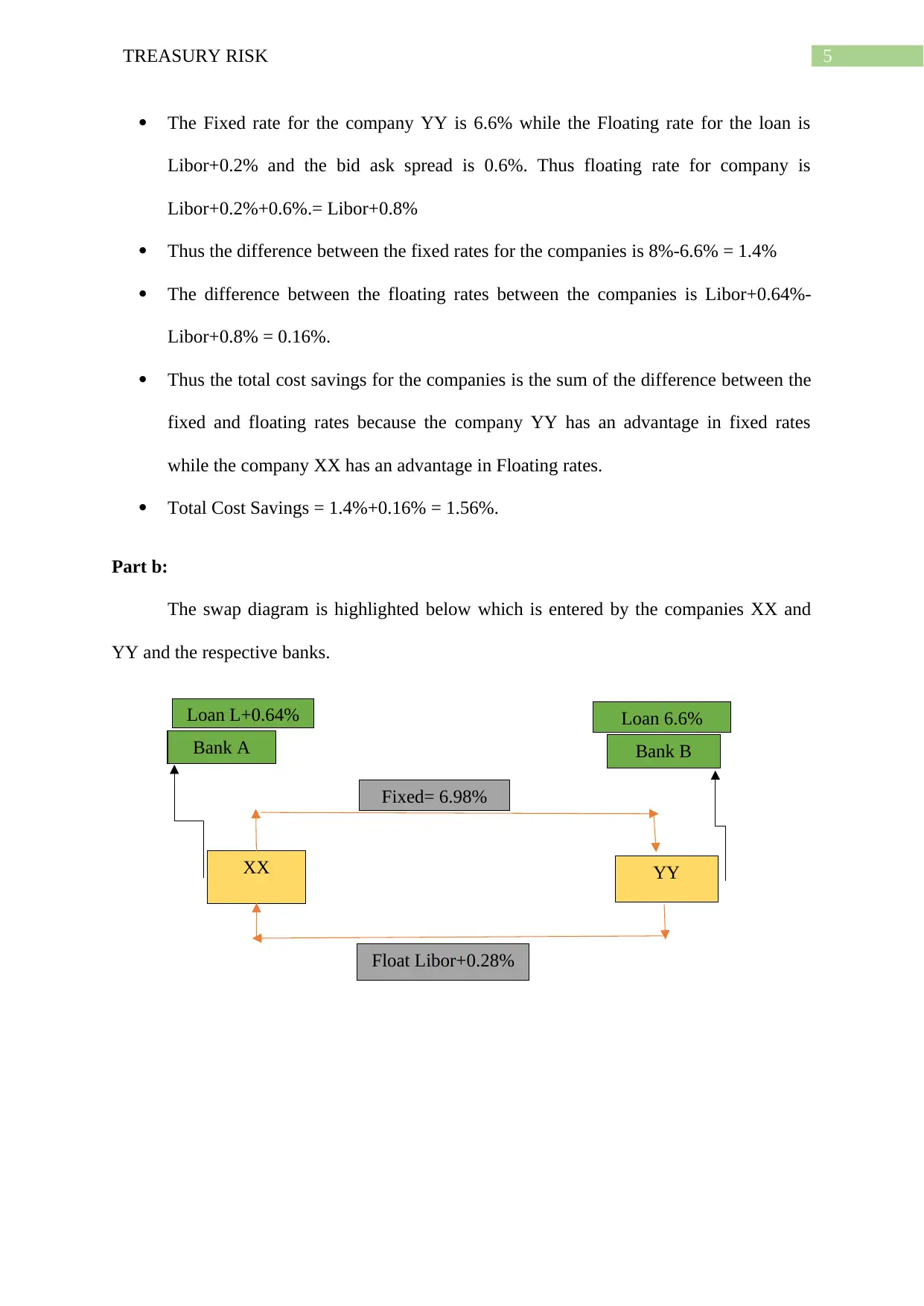
5TREASURY RISK
XX YY
Bank A Bank B
Fixed= 6.98%
Float Libor+0.28%
Loan L+0.64% Loan 6.6%
The Fixed rate for the company YY is 6.6% while the Floating rate for the loan is
Libor+0.2% and the bid ask spread is 0.6%. Thus floating rate for company is
Libor+0.2%+0.6%.= Libor+0.8%
Thus the difference between the fixed rates for the companies is 8%-6.6% = 1.4%
The difference between the floating rates between the companies is Libor+0.64%-
Libor+0.8% = 0.16%.
Thus the total cost savings for the companies is the sum of the difference between the
fixed and floating rates because the company YY has an advantage in fixed rates
while the company XX has an advantage in Floating rates.
Total Cost Savings = 1.4%+0.16% = 1.56%.
Part b:
The swap diagram is highlighted below which is entered by the companies XX and
YY and the respective banks.
XX YY
Bank A Bank B
Fixed= 6.98%
Float Libor+0.28%
Loan L+0.64% Loan 6.6%
The Fixed rate for the company YY is 6.6% while the Floating rate for the loan is
Libor+0.2% and the bid ask spread is 0.6%. Thus floating rate for company is
Libor+0.2%+0.6%.= Libor+0.8%
Thus the difference between the fixed rates for the companies is 8%-6.6% = 1.4%
The difference between the floating rates between the companies is Libor+0.64%-
Libor+0.8% = 0.16%.
Thus the total cost savings for the companies is the sum of the difference between the
fixed and floating rates because the company YY has an advantage in fixed rates
while the company XX has an advantage in Floating rates.
Total Cost Savings = 1.4%+0.16% = 1.56%.
Part b:
The swap diagram is highlighted below which is entered by the companies XX and
YY and the respective banks.
⊘ This is a preview!⊘
Do you want full access?
Subscribe today to unlock all pages.

Trusted by 1+ million students worldwide
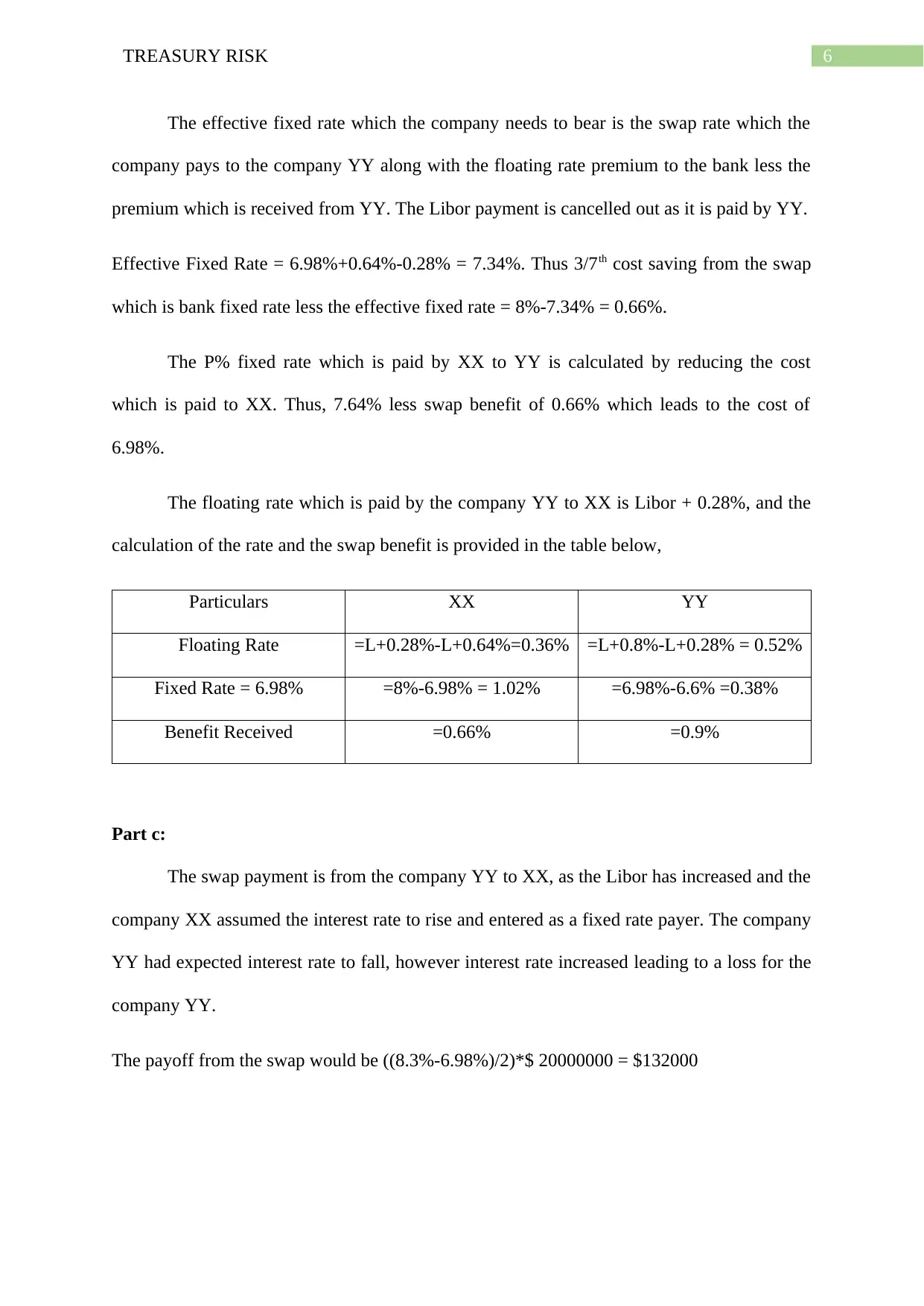
6TREASURY RISK
The effective fixed rate which the company needs to bear is the swap rate which the
company pays to the company YY along with the floating rate premium to the bank less the
premium which is received from YY. The Libor payment is cancelled out as it is paid by YY.
Effective Fixed Rate = 6.98%+0.64%-0.28% = 7.34%. Thus 3/7th cost saving from the swap
which is bank fixed rate less the effective fixed rate = 8%-7.34% = 0.66%.
The P% fixed rate which is paid by XX to YY is calculated by reducing the cost
which is paid to XX. Thus, 7.64% less swap benefit of 0.66% which leads to the cost of
6.98%.
The floating rate which is paid by the company YY to XX is Libor + 0.28%, and the
calculation of the rate and the swap benefit is provided in the table below,
Particulars XX YY
Floating Rate =L+0.28%-L+0.64%=0.36% =L+0.8%-L+0.28% = 0.52%
Fixed Rate = 6.98% =8%-6.98% = 1.02% =6.98%-6.6% =0.38%
Benefit Received =0.66% =0.9%
Part c:
The swap payment is from the company YY to XX, as the Libor has increased and the
company XX assumed the interest rate to rise and entered as a fixed rate payer. The company
YY had expected interest rate to fall, however interest rate increased leading to a loss for the
company YY.
The payoff from the swap would be ((8.3%-6.98%)/2)*$ 20000000 = $132000
The effective fixed rate which the company needs to bear is the swap rate which the
company pays to the company YY along with the floating rate premium to the bank less the
premium which is received from YY. The Libor payment is cancelled out as it is paid by YY.
Effective Fixed Rate = 6.98%+0.64%-0.28% = 7.34%. Thus 3/7th cost saving from the swap
which is bank fixed rate less the effective fixed rate = 8%-7.34% = 0.66%.
The P% fixed rate which is paid by XX to YY is calculated by reducing the cost
which is paid to XX. Thus, 7.64% less swap benefit of 0.66% which leads to the cost of
6.98%.
The floating rate which is paid by the company YY to XX is Libor + 0.28%, and the
calculation of the rate and the swap benefit is provided in the table below,
Particulars XX YY
Floating Rate =L+0.28%-L+0.64%=0.36% =L+0.8%-L+0.28% = 0.52%
Fixed Rate = 6.98% =8%-6.98% = 1.02% =6.98%-6.6% =0.38%
Benefit Received =0.66% =0.9%
Part c:
The swap payment is from the company YY to XX, as the Libor has increased and the
company XX assumed the interest rate to rise and entered as a fixed rate payer. The company
YY had expected interest rate to fall, however interest rate increased leading to a loss for the
company YY.
The payoff from the swap would be ((8.3%-6.98%)/2)*$ 20000000 = $132000
Paraphrase This Document
Need a fresh take? Get an instant paraphrase of this document with our AI Paraphraser
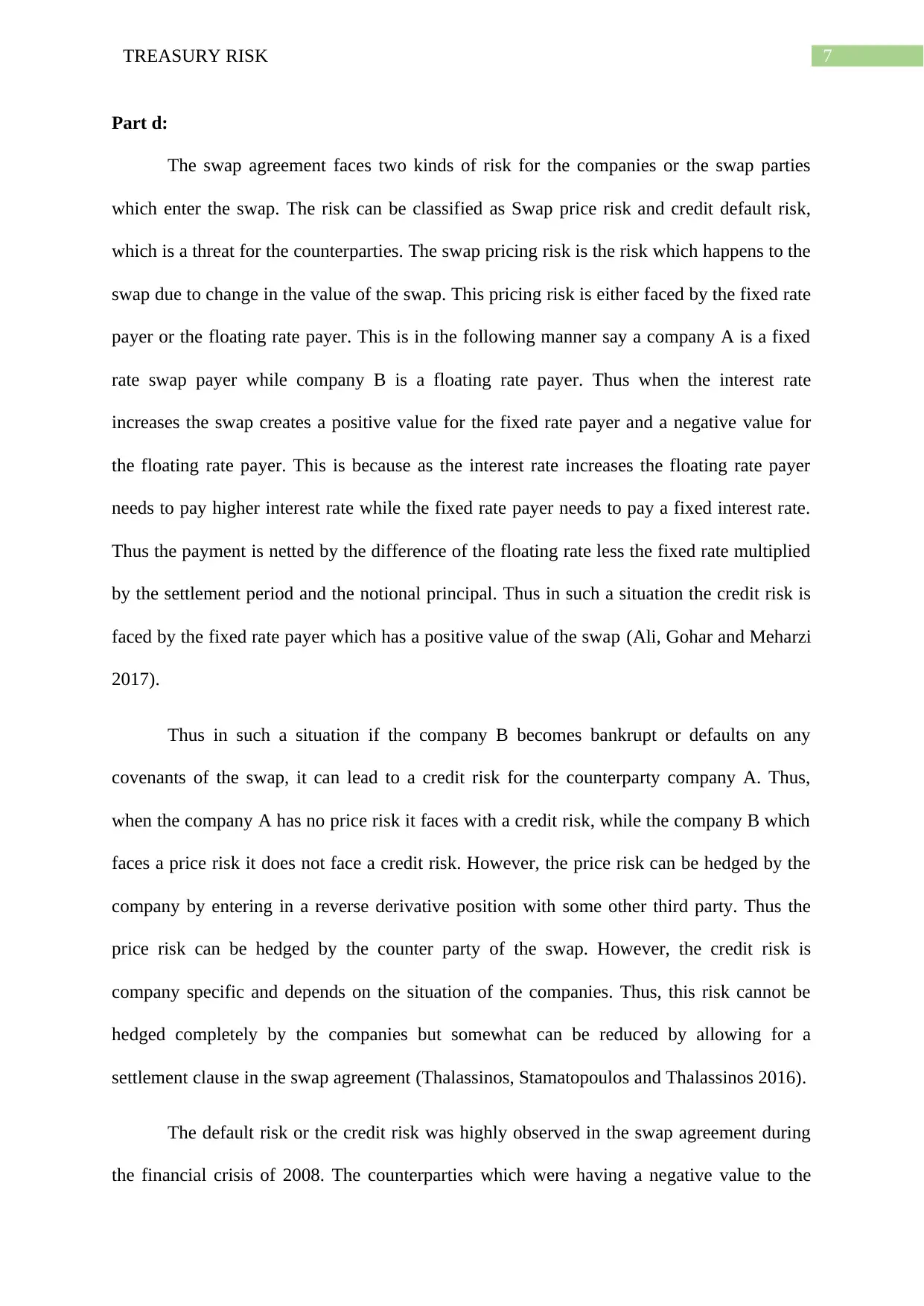
7TREASURY RISK
Part d:
The swap agreement faces two kinds of risk for the companies or the swap parties
which enter the swap. The risk can be classified as Swap price risk and credit default risk,
which is a threat for the counterparties. The swap pricing risk is the risk which happens to the
swap due to change in the value of the swap. This pricing risk is either faced by the fixed rate
payer or the floating rate payer. This is in the following manner say a company A is a fixed
rate swap payer while company B is a floating rate payer. Thus when the interest rate
increases the swap creates a positive value for the fixed rate payer and a negative value for
the floating rate payer. This is because as the interest rate increases the floating rate payer
needs to pay higher interest rate while the fixed rate payer needs to pay a fixed interest rate.
Thus the payment is netted by the difference of the floating rate less the fixed rate multiplied
by the settlement period and the notional principal. Thus in such a situation the credit risk is
faced by the fixed rate payer which has a positive value of the swap (Ali, Gohar and Meharzi
2017).
Thus in such a situation if the company B becomes bankrupt or defaults on any
covenants of the swap, it can lead to a credit risk for the counterparty company A. Thus,
when the company A has no price risk it faces with a credit risk, while the company B which
faces a price risk it does not face a credit risk. However, the price risk can be hedged by the
company by entering in a reverse derivative position with some other third party. Thus the
price risk can be hedged by the counter party of the swap. However, the credit risk is
company specific and depends on the situation of the companies. Thus, this risk cannot be
hedged completely by the companies but somewhat can be reduced by allowing for a
settlement clause in the swap agreement (Thalassinos, Stamatopoulos and Thalassinos 2016).
The default risk or the credit risk was highly observed in the swap agreement during
the financial crisis of 2008. The counterparties which were having a negative value to the
Part d:
The swap agreement faces two kinds of risk for the companies or the swap parties
which enter the swap. The risk can be classified as Swap price risk and credit default risk,
which is a threat for the counterparties. The swap pricing risk is the risk which happens to the
swap due to change in the value of the swap. This pricing risk is either faced by the fixed rate
payer or the floating rate payer. This is in the following manner say a company A is a fixed
rate swap payer while company B is a floating rate payer. Thus when the interest rate
increases the swap creates a positive value for the fixed rate payer and a negative value for
the floating rate payer. This is because as the interest rate increases the floating rate payer
needs to pay higher interest rate while the fixed rate payer needs to pay a fixed interest rate.
Thus the payment is netted by the difference of the floating rate less the fixed rate multiplied
by the settlement period and the notional principal. Thus in such a situation the credit risk is
faced by the fixed rate payer which has a positive value of the swap (Ali, Gohar and Meharzi
2017).
Thus in such a situation if the company B becomes bankrupt or defaults on any
covenants of the swap, it can lead to a credit risk for the counterparty company A. Thus,
when the company A has no price risk it faces with a credit risk, while the company B which
faces a price risk it does not face a credit risk. However, the price risk can be hedged by the
company by entering in a reverse derivative position with some other third party. Thus the
price risk can be hedged by the counter party of the swap. However, the credit risk is
company specific and depends on the situation of the companies. Thus, this risk cannot be
hedged completely by the companies but somewhat can be reduced by allowing for a
settlement clause in the swap agreement (Thalassinos, Stamatopoulos and Thalassinos 2016).
The default risk or the credit risk was highly observed in the swap agreement during
the financial crisis of 2008. The counterparties which were having a negative value to the
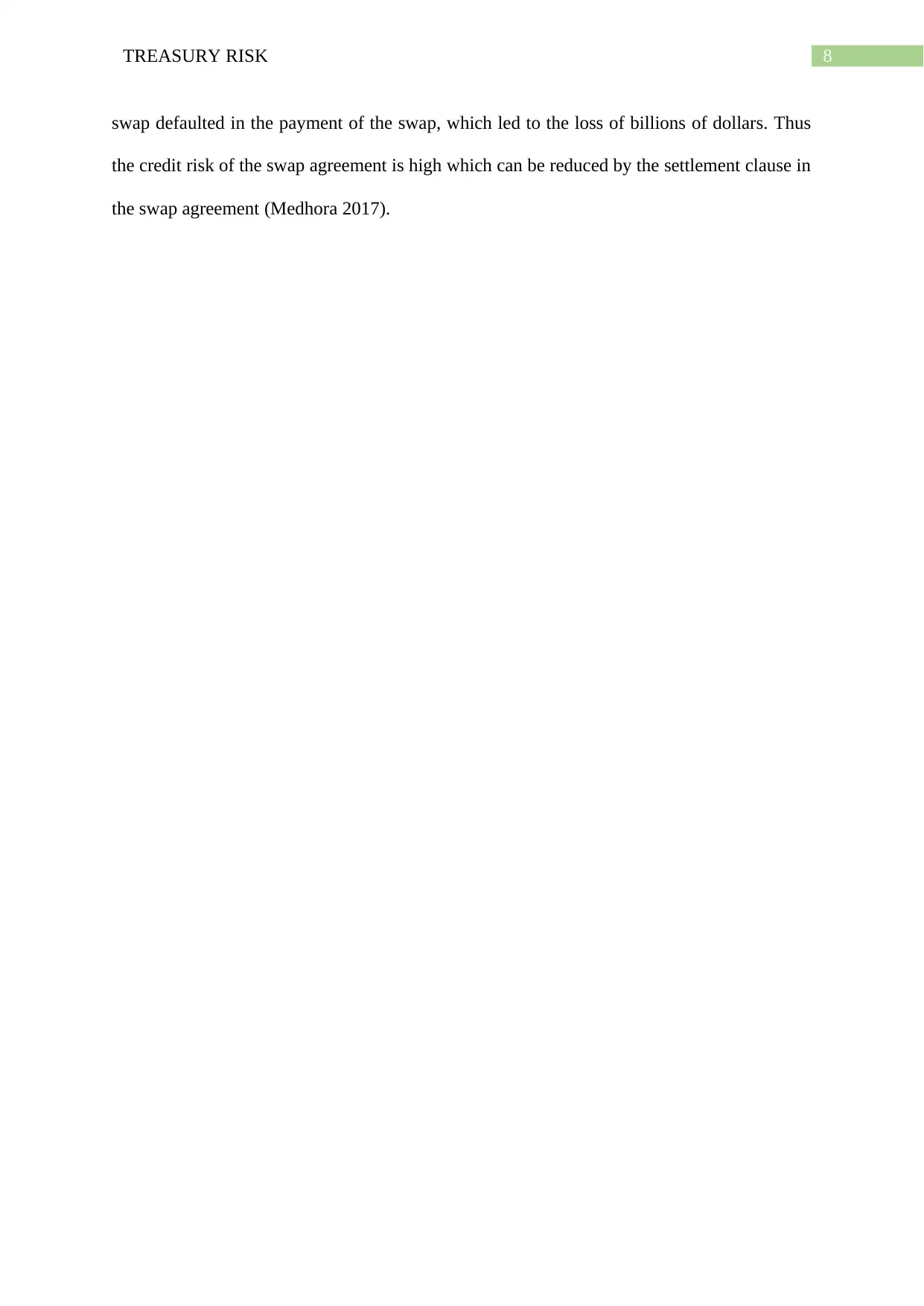
8TREASURY RISK
swap defaulted in the payment of the swap, which led to the loss of billions of dollars. Thus
the credit risk of the swap agreement is high which can be reduced by the settlement clause in
the swap agreement (Medhora 2017).
swap defaulted in the payment of the swap, which led to the loss of billions of dollars. Thus
the credit risk of the swap agreement is high which can be reduced by the settlement clause in
the swap agreement (Medhora 2017).
⊘ This is a preview!⊘
Do you want full access?
Subscribe today to unlock all pages.

Trusted by 1+ million students worldwide
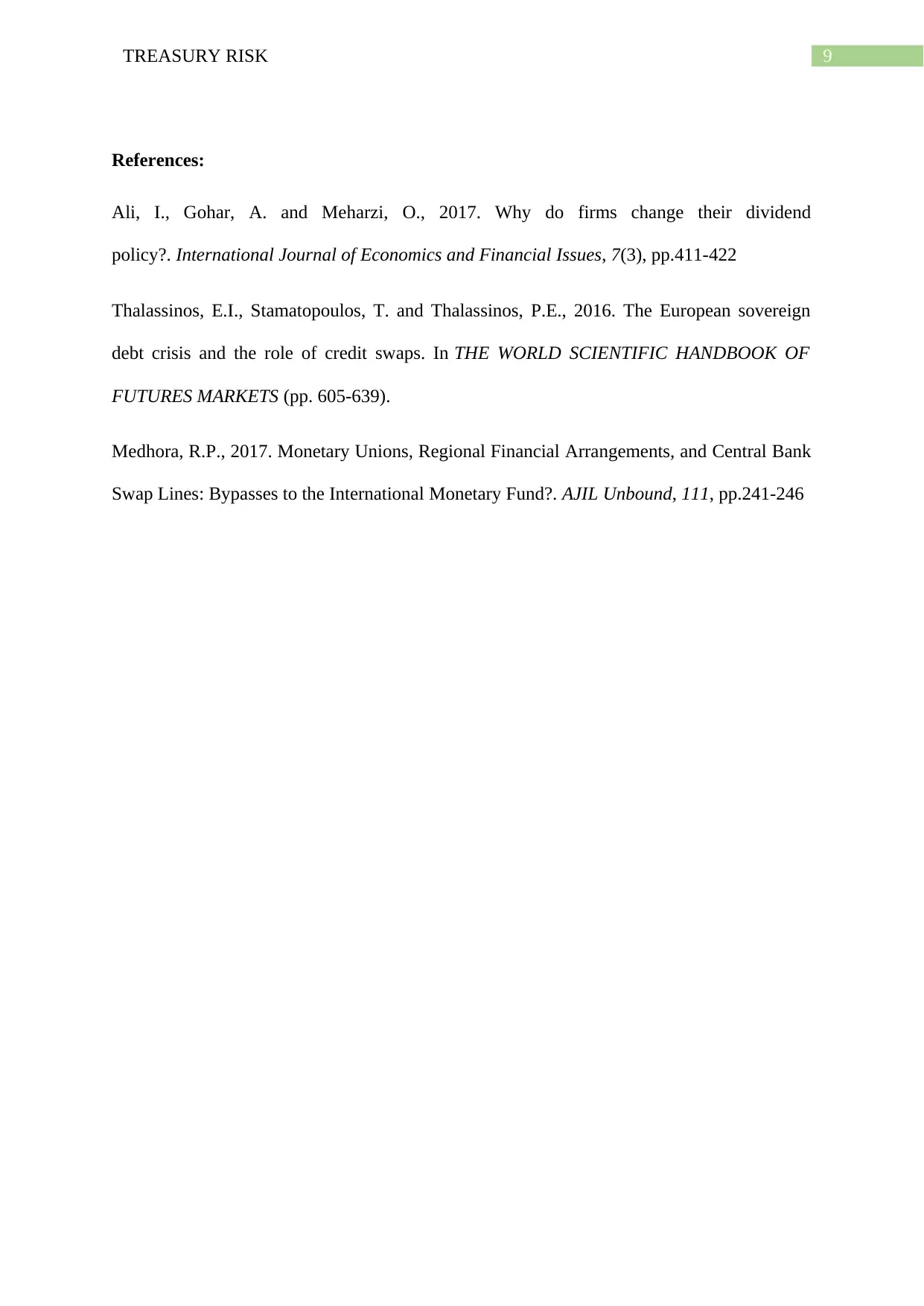
9TREASURY RISK
References:
Ali, I., Gohar, A. and Meharzi, O., 2017. Why do firms change their dividend
policy?. International Journal of Economics and Financial Issues, 7(3), pp.411-422
Thalassinos, E.I., Stamatopoulos, T. and Thalassinos, P.E., 2016. The European sovereign
debt crisis and the role of credit swaps. In THE WORLD SCIENTIFIC HANDBOOK OF
FUTURES MARKETS (pp. 605-639).
Medhora, R.P., 2017. Monetary Unions, Regional Financial Arrangements, and Central Bank
Swap Lines: Bypasses to the International Monetary Fund?. AJIL Unbound, 111, pp.241-246
References:
Ali, I., Gohar, A. and Meharzi, O., 2017. Why do firms change their dividend
policy?. International Journal of Economics and Financial Issues, 7(3), pp.411-422
Thalassinos, E.I., Stamatopoulos, T. and Thalassinos, P.E., 2016. The European sovereign
debt crisis and the role of credit swaps. In THE WORLD SCIENTIFIC HANDBOOK OF
FUTURES MARKETS (pp. 605-639).
Medhora, R.P., 2017. Monetary Unions, Regional Financial Arrangements, and Central Bank
Swap Lines: Bypasses to the International Monetary Fund?. AJIL Unbound, 111, pp.241-246
1 out of 10
Related Documents
Your All-in-One AI-Powered Toolkit for Academic Success.
+13062052269
info@desklib.com
Available 24*7 on WhatsApp / Email
![[object Object]](/_next/static/media/star-bottom.7253800d.svg)
Unlock your academic potential
Copyright © 2020–2025 A2Z Services. All Rights Reserved. Developed and managed by ZUCOL.





